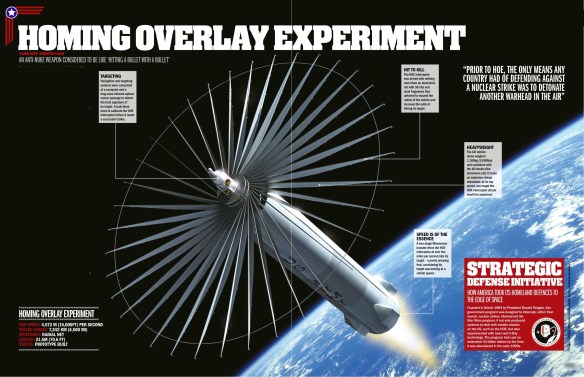AN ANTI-NUKE WEAPON CONSIDERED TO BE LIKE ‘HITTING A BULLET WITH A BULLET’.
At the Cold War peak in the 1980s, the deployment of weapons and defence systems from space (or at least, extremely high altitude) became the new playthings for both Communist and Western governments. On the US side of the Atlantic, president Ronald Reagan’s opposition to the doctrine of mutually assured destruction meant that the US military was investing time into researching the means of defending America against a nuclear strike, rather than the weapons required for a retaliatory attack. Cue the Homing Overlay Experiment (HOE).
In 1984, the US Army launched two missiles at each other from either side of the Pacific. One was launched from California with a dummy warhead and a trajectory that would take it 7,242 kilometres (4,500 miles) away to a spot near Kwajalein Atoll. The army waited for the missile to pop up on Kwajalein’s radar before launching their experimental counter-measure to intercept it. This was a kinetic weapon that looked much like another missile, until it approached the nuclear dummy outside Earth’s atmosphere at more than 185 kilometres (114 miles) altitude. Here, it unfurled a huge, ribbed aluminium net to increase its lethal radius and made directly for the dummy, striking it at such speed that both were practically vaporised. This fourth test was the first to be considered a success and was likened to shooting a bullet out of the air in mid-flight with another bullet.
This was the first non-nuclear missile defence technology: prior to HOE, the only means any country had of defending against a nuclear strike was to detonate another warhead in the air to destroy everything in its blast radius. Obviously, the subsequent radioactive fallout from this method could have had dire consequences for the world. While HOE itself was, thankfully, never needed, the force-of-impact technology it pioneered has been passed down to today’s US missile defence systems.
